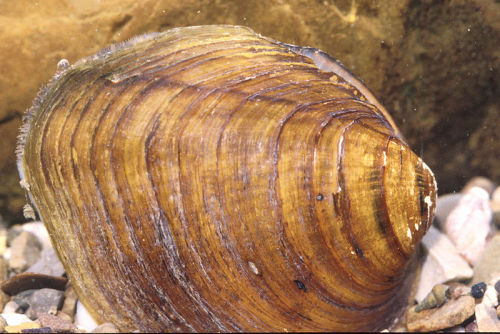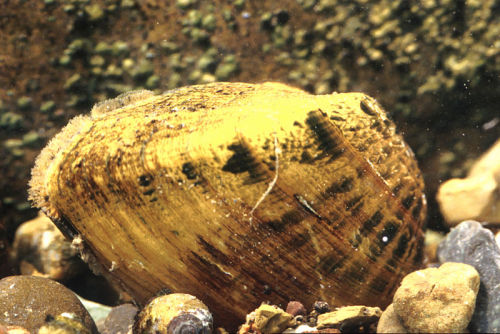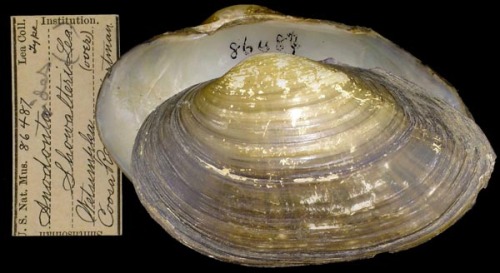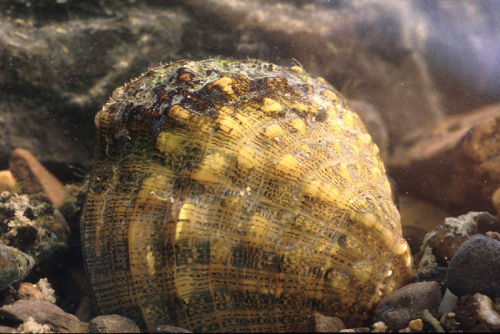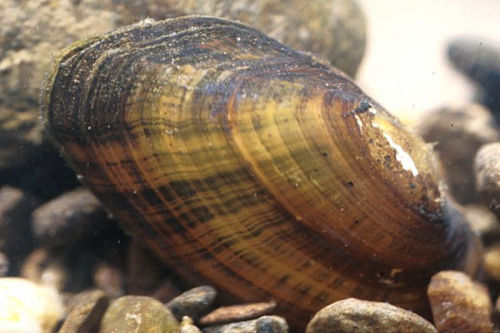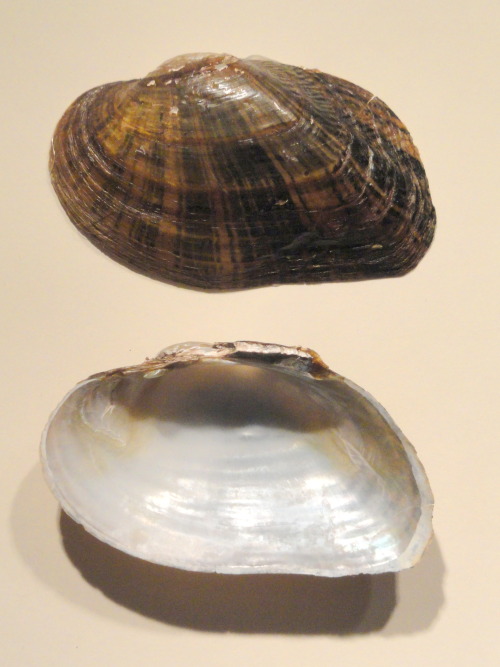
Hi, I'm Andrew and I’m just a simple zoology student and crustacean researcher from Ohio. This blog centers around animal IDs so feel free to send me any unknown species (and its location) that you have and I will take my best shot at IDing it! I also occasionally post random zoology/animal factoid things.
Disclamer: none of the pictures are mine unless stated
Catching Elephant is a theme by Andy Taylor
“Slippershell” (Alasmidonta viridis)
Also known as the Brook Wedge Mussel, the slippershell is a species of freshwater Unionid bivalve which is distributed throughout parts of the Midwest and Southeast United States. It also occurs in Canada along the great lakes. Slippershells typically occur in creeks and the headwaters of rivers. However, they are also known to occur in larger rivers and lakes.
Although Alasmidonta viridis is listed as Least Concern its population is decreasing in number, and in some areas it is either threatened or considered to be endangered.
Classification
Animalia-Mollusca-Bivalvia-Palaeoheterodonta-Unionoida-Unionidae-Alasmidonta-A. viridis
Image: Dick Biggins
Rabbitsfoot (Quadrula cylindrica)
…a species of freshwater Unionid bivalve which is distributed throughout the Midwest and Southeast United States, where it occurs in 13 different states. Historically Q. cylindrica was known to inhabit 137 different stream systems in 15 states, but it is know restricted to 46 systems in 13 states. Rabbitsfeet typically prefer moderately flowing, clear, shallow streams, creeks, and rivers where they are found around the bank in runs and shoals.
Quadrula cylindrica is currently listed as near threatened as it has suffered from habitat loss and is sensitive to changes in its environment
Classification
Animalia-Mollusca-Bivalvia-Palaeoheterodonta-Unionoida-Unionidae-Quadrula-Q. cylindrica
Long Solid Mussel (Fusconaia subrotunda)
Also known as the longsolid, long solid naiad or “pigtoe” the long solid mussel is a species of freshwater Unionid bivalve which is distributed throughout the United States and Canada. Where historically it inhabited the Ohio, Cumberland, and Tennessee River drainages. It’s current range is still largely unknown but has likely decreased. Long solid mussels typically inhabit small to large rivers with gravel and strong currents.
Fusconaia subrotunda is currently listed as Vulnerable as like most Unionids it is very sensitive to changes in its environment, which could cause it to decline at a higher rate.
Classification
Animalia-Mollusca-Bivalvia-Palaeoheterodonta-Unionoida-Unionidae-Fusconaia-F. subrotunda
Image: Dick Biggins
Aggressive Parasitism
Recently I posted about the Snuffbox (Epioblasma triquetra) and I covered abit about their unique reproductive strategy. I didn’t go into as much detail as I could because I wanted to save it for its own unique post.
Snuffboxes like other Unionid bivalves use parasitic glochidium larvae to aid in dispersal. However, unlike other Unionids which use conglutinates to attract their fish hosts, snuffboxes use a more aggressive approach. The main host of the snuffbox is the Common Logperch (Percina caprodes), which feeds by using its reinforced snout to flip over rocks and pebbles to feed on the small invertebrates hiding underneath them. female Snuffboxes (and some other members of Epioblasma) exploit this by camouflaging themselves as rocks, and when a logperch decides to flip one she will quickly clamp onto the snout of the logperch and begin pump her larvae into the logperch’s mouth! Which you can see occurring above.
When this occurs the female Epioblasma can hold on to the shocked fish by using her powerful adductor muscles which hold her shell shut. Some species also possess menacing spikes on the edge of their shells, which are known as denticles (shown below).

Image: ©M. C. Barnhart (Denticles on E. torulosa)
These really allow Epioblasma spp. to hold onto their wriggling hosts. Once a logperch is caught the female Epioblasma will puff up her mantle, forming a “seal” between her and the fish (see image below).

Image: ©M. C. Barnhart
Once the logperch is effectively sealed in, she will start pumping her glochidia into it’s mouth where they will pass through the gills where they will attempt to attach themselves (see below).

(If you look closely you can see some glochidia (white specks) passing through the logperch’s gills)
Once she is done the female Epioblasma will release the logperch, which will swim away carrying away the glochidia. In time they will drop off and the cycle will repeat itself.
There is a dark reason that Epioblasma use solely logperches for this strategy. This is not only because of the logperch’s feeding method, it is because of the logperchs thick skull! Experiment’s have been done where Epioblasma have been isolated with darters. When the darters got too close to the Epioblasma it did what it would do to a logperch. But since darters aren’t used to flipping over rocks they have less thick skulls. This caused the Epioblasma to either crush the darter’s skull or suffocate it! (If you don’t believe me a video can be seen here [not for the faint of heart]) That means this strategy can only work with logperches.
Videos: Chris Barnhart and ssaft
For more info on Epioblasma please check out M. C. Barnhart’s Unio Gallery!
Snuffbox (Epioblasma triquetra)
…an endangered species of freshwater Unionid bivalve which is distributed throughout the Great Lakes and Mississippi Systems in North America, ranging from western New York and southern Ontario, west to Wisconsin, Iowa, and eastern Nebraska, south to Oklahoma, and east to northern Alabama. Snuffboxes typically occur in small to medium sized rivers, but are known to inhabit streams as well.
Snuffboxes are most well known for their reproduction strategy. Unlike most Unionids which use lures to get fish close, snuffboxes are more direct. The primary host of the snuffbox is the Common Logperch (Percina caprodes) which forages by turning over rocks to feed on whatever is seeking refuge under them. To get logperches to ingest their larvae female snuffboxes camouflage themselves and rocks and when a logperch attempts to flip one, she will quickly clamp onto the head of the logperch and directly pump her glochidia into the logperches gills. This strategy will only work with logperches as they have a thick enough skull to not get crushed when they get clamped!
Classification
Animalia-Mollusca-Bivalvia-Palaeoheterodonta-Unionoida-Unionidae-Epioblasma-E. triquetra
Image: Dick Biggins
Rayed Cakeshell (Anodontoides radiatus)
…a species of freshwater Unionid bivalve which is known to occur in Georgia, Alabama, and Mississippi, Louisiana, and Florida in the United States. In this range Anodontoides radiatus occurs in isolated and fragmented areas. Despite this A. radiatus is still widespread and “only” listed as Near Threatened. Rayed cakeshells are typically known to inhabit large rivers, but they will also medium-sized creeks as well.
Classification
Animalia-Mollusca-Bivalvia-Palaeoheteodonta-Unionoida-Unionidae-Anodontoides-A. radiatus
Image: UWSP
Birdwing Pearlymussel (Lemiox rimosus)
…a Critically Endangered species of freshwater Unionid bivalve which is endemic to the states of Tennessee and Virginia in the United States, where it occurs in the Duck, Clinch, and Powell River Systems. Like many other Unionids L. rimosus historically had a much larger range, but has now been extirpated from 90% of its former range. Birdwing pearlymussels are almost exclusively found in riffle areas with sand or gravel substrates in moderate to fast currents.
Currently Lemiox rimosus is listed as Critically Endangered as it faces major threats from the alteration and destruction of the limited habitat it occupies.
Classification
Animalia-Bivalvia-Palaeoheterodonta-Unionoida-Unionidae-Lampsilini-Lemiox-L. rimosus
Image: Dick Biggins
“Fanshell” (Cyprogenia stegaria)
….a Critically Endangered species of freshwater Unionid bivalve which is endemic to the United States, where it is only known to occur in three river systems. These systems are the Clinch River in Tennessee and Virginia, and the Green and Licking Rivers in Kentucky. A small population might also exist in the Tennessee River. Fanshells typically inhabit medium to large rivers and occur in gravel riffles.
Currently Cyprogenia stegaria is listed as Critically Endangered as it is very sensitive to environmental changes. And suffers from having a reduced range.
Classification
Animalia-Mollusca-Bivalvia-Palaeoheterodonta-Unionoida-Unionidae-Cyprogenia-C. stegaria
Image: Dick Biggins
Appalachian Elktoe (Alasmidonta raveneliana)
….a critically endangered species of freshwater Unionid bivalve which is endemic to several mountain river systems in western North Carolina and eastern Tennessee. Specifically, the Little Tennessee and Pigeon River systems in Tennessee and the Little River and Nolichucky River systems in North Carolina. Although historical data is scarce, it is thought that A. raveneliana once possessed a much large range throughout upper Tennessee.
Currently Alasmidonta raveneliana is listed as critically endangered, as it possess a reduced range and has been affected by environmental change through runoff and construction.
Classification
Animalia-Mollusca-Bivalvia-Palaeoheterodonta-Unionoida-Unionidae-Alasmidonta-A. raveneliana
Image: Dick Biggins
Pink Mucket (Lampsilis abrupta)
Also known as the pink mucket pearly mussel, Lampsilis abrupta is a species of freshwater Unionid bivalve which was formerly widespread throughout the United States, occurring in 25 different river systems. It now solely occurs in several fragmented areas in the central United States, from parts of Ohio to Arkansas.
Lampsilis abrupta is currently listed as Endangered throughout all of its range. Its decline has been attributed to the loss of suitable habitat due to dredging and the building of dams, as well as habitat loss and destruction.
Classification
Animalia-Mollusca-Bivalvia-Palaeoheterodonta-Unionoida-Unionidae-Lampsilis-L. abrupta
Image: Craig Stihler
julierie replied to your photo “Tar River Spiny Mussel (Elliptio steinstansana) …a sp…”
I was wondering, are the Unionidae only endemic to North America? I really like these posts, by the way! :)
Thank you! The Unionids are actually not endemic to North America, they occur in Europe, Africa, and Asia as well. They are just super diverse in North America, so much so that the US has been referred to as “The Amazon Rainforest of mussels"
Tar River Spiny Mussel (Elliptio steinstansana)
….a species of freshwater Unionid bivalve which is now endemic to North Carolina, in the United States. Elliptio steinstansana used to be well distributed throughout the United States, but due to habitat loss and destruction it is now restricted to less than 5% of its former range.
Elliptio steinstansana is currently listed as Critically Endangered, as it suffers from having a small range and is still declining. It is currently expected to go extinct without significant human intervention.
Classification
Animalia-Mollusca-Bivalvia-Palaeoheterodonta-Unionoida-Unionidae-Elliptio-E. steinstansana
Image: Dick Biggins

Super-conglutinates + conglutinates!
In my last post I explained that some female Unionid bivalves use an extension of their mantles known as a super-conglutinate to aid in “luring” fish close enough for their parasitic Glochidium larvae to latch on to their gills. But I didn’t go into much detail on how super-conglutinates function. This is because they are so unique and awesome and they needed their own post!
As I previously stated super-conglutinates are simply an extension of the mussel’s mantle, which generally resemble a small fish or aquatic inveterate and are waved back and forth. Super-conglutinates are formed of multiple "packages" (known as conglutinates) of glochidia larvae which are grouped together into one “super” conglutinate. This is more easily seen on less complex conglutinates:

Image: USGS (Lampsilis australis super-conglutinate)
Conglutinates are used to lure hungry fish into biting them, when this happens they will burst and hundreds of glochidia larvae swarm and latch onto the fish.
That’s not the best part though! In-order to keep fish falling for their ruse, different Unionid species have evolved increasingly more complex and convincing conglutinate "designs" to keep the fish biting. And some of these “designs” are just simply amazing! One of the more well known is that of some members of the genus Lampsilis which have modified their conglutinates to form what looks strikingly like a small fish! (see above) These are waved back and forth and used to attract large fish like bass.
Not all unionids attempt to mimic fish with their conglutinates. One species Villosa iris attempts to copy the moment of a crayfish scurrying along the bottom, by waving the fringes of their conglutinates, they also have gone as far to “include” a dark fringe to mimic a crayfish’s eyespot.

The Ouachita kidneyshell (Ptychobranchus occidentalis), shown below, will mimic the larvae of insects or small fish with its conglutinates. These conglutinates are released into the water and posses and adhesive “tail” which attaches them to a surface like rocks. They will sit in place until a curious fish swims by, thinking its going to get a meal it will attempt to eat them only to get a mouth full of glochidia.

Other species like to take the concept of a lure more literally and have really interesting conglutinate “designs”. For example the endangered Shinyrayed Pocketbook will hold its conglutinates on a “line” which is long, membranous extension of the main “conglutinate”. This line has a “lure” at the end and is allowed to float in the current, resembling a small fish swimming!

Shinyrayed Pocketbook (Hamiota subangulata) “fly-fishing”
Species like the Western fanshell (Cyprogenia alberti) also have elongate lures. However their lures are smaller and are used to mimic tiny wriggling aquatic worms.

Image: ©M. C. Barnhart (The lure of C. alberti)
These are only some of the many amazing techniques used by Unionids to lure fish into ingesting their parasitic glochidia larvae. Many other species will use different techniques and mimic other taxa, but all of these displays are solutions for the problem of dispersal in a directional flowing environment, and that’s really awesome!
If you want to see more (and trust me you do) I urge you to check out M. C. Barnhart’s Unio Gallery for more awesome information
Videos: Johann M, Matt Hill, SWGMUSSELS, Chris Barnhart
Brook Floater (Alasmidonta varicosa)
….a species of freshwater unionid bivalve, which is known to occur in New Brunswick and Nova Scotia in Canada, and the majority of the eastern United States. Brook floaters will typically inhabit high relief streams and are mostly seen under boulders and sand.
Although A. varicosa is listed as “Data Deficient” by the IUCN, it (like most unionids) is very sensitive to environmental changes which could cause a decline in its population.
Classification
Animalia-Mollusca-Bivalvia-Palaeoheterodonta-Unionoida-Unionidae-Alasmidonta-A. varicosa
Image: Daderot
Fluted Kidneyshell (Ptychobranchus subtentum)
…a species of freshwater unionid bivalve, which is endemic to the Cumberland River and Tennessee River drainages in the United States. Like other unionids female P. subtentum are known to use superconglutinates to draw fish close enough to them to allow for a releasing of their parasitic larvae. P. subtentum is especially known to mimic the larvae of black flies (Simuliidae) with their superconglutinates.
Classification
Animalia-Mollusca-Bivalvia-Palaeoheterodonta-Unionoida-Unionidae-Ptychobranchus-P. subtentum
Image: Dick Biggins



